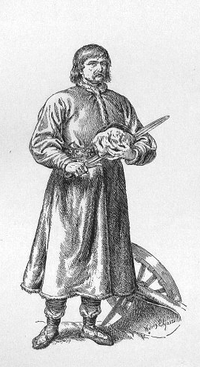| Piast the Wheelwright | |
|---|---|
 Portrait of Piast the Wheelwright Portrait of Piast the Wheelwright | |
| Duke of the Polans | |
| Predecessor | Popiel |
| Successor | Siemowit |
| Born | 740/741? |
| Died | 861 (claimed age 120) |
| Spouse | Rzepicha |
| Issue | Siemowit |
| House | Piast (founder) |
| Father | Chościsko |
| Religion | Slavic paganism |
Piast the Wheelwright (c. 740/741? – 861 AD; Polish: Piast Kołodziej , Piast Oracz, i.e. Piast the Plower, or Piast; Piast Chościskowic, Latin: Past Ckosisconis, Pazt filius Chosisconisu) was a legendary figure in medieval Poland (9th century AD), the progenitor of the Piast dynasty that ruled the Kingdom of Poland.
Legend

Piast makes an appearance in the Polish Chronicle of Gallus Anonymus, along with his father, Chościsko, and Piast's wife, Rzepicha.
The chronicle tells the story of an unexpected visit paid to Piast by two strangers. They ask to join Piast's family in celebration of the 7th birthday (a pagan rite of passage for young boys) of Piast's son, Siemowit. In return for the hospitality, the guests cast a spell making Piast's cellar ever full of plenty. Seeing this, Piast's compatriots declared him their new prince, to replace the late Prince Popiel.
If Piast really existed, he would have been the great-great-grandfather of Prince Mieszko I (c. 930–92), the first historic ruler of Poland, and the great-great-great-grandfather of Bolesław I the Brave (967–1025), the first Polish king.
The legendary Piasts were native of Gniezno, a well-fortified castle town founded between the eighth and ninth century, within the tribal territory of the Polans.
According to legend, he died in 861 aged 120 years.
Legacy

Across more than the next thousand years, no figure in Polish history was named Piast.
Two theories explain the etymology of the word Piast. The first gives the root as piasta (" hub" in Polish), a reference to his profession. The second relates Piast to piastun ("custodian" or "keeper"). This could hint at Piast's initial position as a majordomo, or a "steward of the house", in the court of another ruler, and the subsequent takeover of power by Piast. This would parallel the development of the early medieval Frankish dynasties, when the Mayors of the Palace of the Merovingian kings gradually usurped political control.
References
- ^ Prichard, James C. (1836). Researches into the Physical History of Mankind. Vol. 1. London: Houlston and Stoneman. pp. 11–5 ff.
- Badania krytyczno-historyczne i literackie by Jozafat Bolesław Ostrowski, 1870 (Polish)
- Polish cognomen “Chościskowic” and its Latin versions of “Ckosisconis” and “filius Chosisconisu” (lit. son of Chosisco) refer to his father, supposedly named “Chościsko”
- Norman Davies (23 August 2001). Heart of Europe: The Past in Poland's Present. Oxford University Press. p. 249. ISBN 978-0-19-280126-5. Retrieved 29 February 2012.
- Excerpts from the Gallus Anonymus' chronicle, PL: Gimnazjum, archived from the original on 2009-01-25, retrieved 2009-04-02.
- Dzięcioł, W. (1966). The origins of Poland. London: Veritas.
- Jasienica, Pawel (1985). Piast Poland. American Institute of Polish Culture. p. 26. ISBN 9781881284000.
| Monarchs of Poland | |
|---|---|
| Legendary | |
| Proto-historic (before 966) | |
| Piast dynasty (966–1138) | |
| Fragmentation period (1138–1320) | Senior or Supreme Princes
|
| Přemyslid dynasty (1296–1306) |
|
| Restored Piast dynasty (1320–1370) | |
| Capet-Anjou dynasty (1370-1399) | |
| Jagiellonian dynasty (1386–1572) | |
| Elective monarchy (1572–1795) | |
| Duchy of Warsaw (1807–1815) | Frederick Augustus I |
| Romanov dynasty (1815–1917) | |
| |